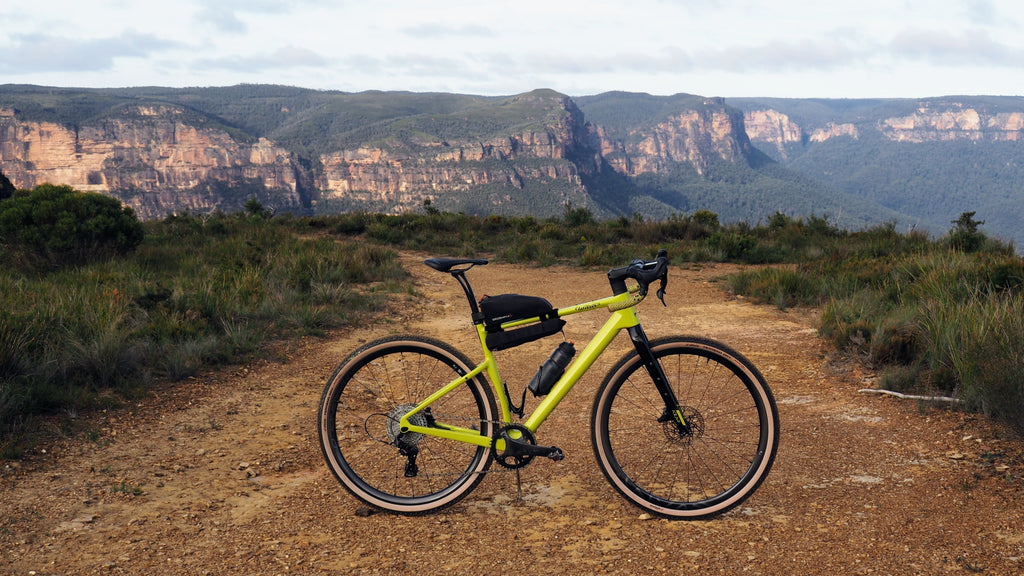Words & Photography: Alison McGregor
You don’t truly know a bike until you’re forced to rely on it—completely.
Not just on bitumen, but when the sealed road disappears, the gravel loosens beneath you, and a sudden pinch climb forces a decision between fight or walk. That’s where I met the Wilier Adlar—on a ride that blurred road, trail, time, and trust.
According to Wilier, the Adlar is “made for bikepacking, for explorers, for bike travellers”. I thought Id put this quote to the test on varied terrain. What I found was that this frame is built with touring resilience, mountain bike DNA, and gravel-bike responsiveness. More than a methodical tourer, the Adlar is Wilier’s answer to riders who want to go far, carry more, and tackle terrain that doesn’t come with warning signs. And in a region like the Blue Mountains, where the gravel can shift from compact to chaos in a matter of metres, I was ready to see what it could handle.
Spec Summary (Custom Build)
|
Component |
Specification |
|
Frame |
Wilier Adlar Carbon (Lime) |
|
Groupset |
Campagnolo EKAR 1x13, 44T chainring, 9–42 cassette |
|
Brakes |
EKAR hydraulic, 160mm rotors |
|
Wheels |
Campagnolo Levante |
|
Tyres |
Vittoria Terreno Dry 700x47mm (Tubeless) |
|
Handlebar |
Deda Elementi Gera Carbon Gravel Bar |
|
Seatpost |
Ergon Allroad Pro Carbon Setback |
|
Saddle |
Selle Italia Flite Boost TM Superflow |
|
Weight |
~9.9kg (unloaded) |
Wilier offers ready-to-ride Adlar builds starting at $7,200 AUD (Shimano GRX 1x12 with Miche Graff XL) through authorised Australian dealers. This test bike is a custom build.
Frameset: Purpose-Built Balance
At its core, the Adlar is a gravel bike that draws on mountain bike stability without feeling overbuilt. The 70° head angle, long wheelbase, and clearance for 52mm tyres all point to serious intent when it comes to endurance touring. But the real genius is how it handles when loaded.
Wilier’s engineers have clearly focused on maintaining handling neutrality under weight. I’ve ridden bikes that become twitchy or unbalanced once the saddlebags go on, or the weight of electronic rear hub takes control—where climbing and turning on loose gravel turns into a fight between traction and toppling. The Adlar, by contrast, remained planted and predictable, even on descents that required considerable manoeuvring. On shifty, shale-strewn climbs, where body movement has to be precise, the bike never fought me. It tracked clean lines without losing posture.
And at under 10kg, it was light enough to carry when the trail said “not today.” The numerous mounting points (including fork legs and downtube) also mean water and gear can be distributed evenly, preserving the bike’s composure even when fully loaded.
Ride Experience: Stability You Can Feel
My test of the Adlar began on hostile bitumen—narrow shoulders, heavy trucks, and debris-strewn climbs. That’s where the Campagnolo EKAR drivetrain first proved itself, delivering clean, precise shifts under pressure. The bright lime frame did its part in visibility, but when traffic demands instant acceleration, it’s the mechanics that count. In the extremes of traffic where double trucks pelted past and I was left with shoulder no wider than the palm of my hand, it was a considerable relief that the gearing performed perfectly, the braking bit clean, and the bike responded.
But the real revelation came as the road suddenly gave way to dirt.
Climbing into the Blue Mountains ridgelines, the Adlar felt remarkably settled on loose surface transitions. I’ve experienced bikes that skid or slide unpredictably under load—where control becomes guesswork. But with the 47mm Vittoria Terreno tyres, wider Deda Gera bars, and the compliant Ergon seatpost, I never second-guessed the bike’s response. It was stable without feeling sedated—playful when you wanted it, solid when you needed it.
And that sense of fun? It matters. The Adlar delivered genuine joy—not in bursts, but sustained. When the bike becomes invisible beneath you, when you stop negotiating with your machine and start moving with it, the ride becomes memorable. Like dancing with a partner who predicts your moves.
Component Analysis
Campagnolo EKAR 1x13 Drivetrain
Simplicity and smoothness define EKAR. The 9–42 cassette is broad, and shifting is both intuitive and firm. That said, the 44T chainring felt overgeared for steep gravel pinches, especially under partial load. On sealed roads it was fine, but on sharp, low-speed climbs over rocky shale, I would have benefited from a 40T or 42T chainring. This is the one part of the build I’d modify for future longer trips.
Campagnolo Levante Wheels & Vittoria Terreno Dry Tyres
The Levante wheelset strikes the right balance between durability and finesse. It took rough hits without fuss, and the Terreno Dry tyres—despite the name—gripped well across dust, dry rock, and wet patches. Their volume and tread let me ride confidently across surfaces many riders would approach with caution.
Deda Elementi Gera Carbon Bar & Loop Tape
Flared drops offer leverage and descending control, but it’s the overall comfort geometry that made a difference here. Easy to grip and simple to reach the drops. Hats off to how the shifters are positioned - serious comfort that I hadn’t experienced and the proof was in the lack of usual neck strain I come to expect after long gravel routes. After hours in the saddle, the combination of bar shape and bar tape’s plush feel kept wrist/hand fatigue at bay.
Ergon Allroad Pro Carbon Seatpost & Selle Italia Flite Boost Saddle
If you have suffered from pain associated with typical jarring over gravel, you will want to try this seat post. Ive tried a few brands, and the simplicity of this design is astounding. Compliance here was real. The Ergon seatpost muted trail chatter in a subtle, effective way—never feeling squishy. It gave the saddle room to do its job, and it did it well. No unnecessary loss of power that comes with a dropper post. No shuffling and repositioning in the saddle required. Just continued support.
Loaded and Capable: Touring Potential
Were there still moments I could use the comfort and capability of an MTB? Sure, but the Adlar remained light enough to dismount and carry should the risks outweigh the rewards. This helps make the Adlar more than a weekend wanderer. With modular mounting options, mudguard compatibility, and the ability to run bags from Wilier’s Miss Grape partnership, it’s clearly ready for expedition use. Riders like Wiebke Lühmann and Veronica Santandrea have proven that—using the Adlar across mountains and continents with up to 35kg of cargo. And while my ride didn’t involve border crossings, it did demand self-sufficiency, reliability, and resilience.
This bike never flinched.
Conclusion: Engineered for Trust
The Wilier Adlar isn’t built to impress with flash. It builds its reputation the longer you ride it. Stability, comfort, responsiveness—especially under weight—define this frame. The ride becomes smoother, your confidence grows, and the terrain begins to feel less intimidating. That’s not by chance—it’s the result of deliberate engineering and thoughtful component pairing.
No bike is perfect. And this one would benefit from a tighter gear ratio for proper adventure climbing. But when it comes to ride feel, balance, and the joy of just riding, the Adlar delivers something special.
You don’t think or question the bike when it matters most.
You think about the view, the challenge, the terrain and the distance ahead.
And that’s exactly the point when you’re beckoned to travel by bike.




